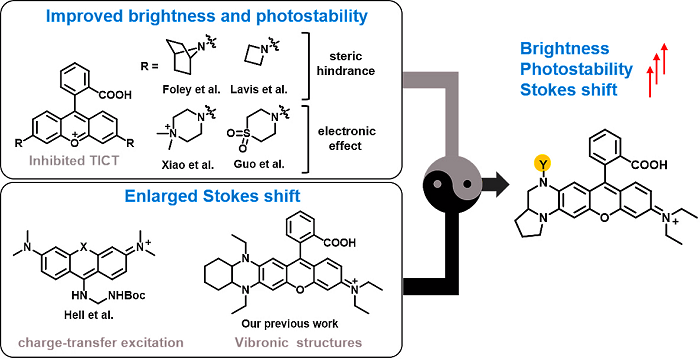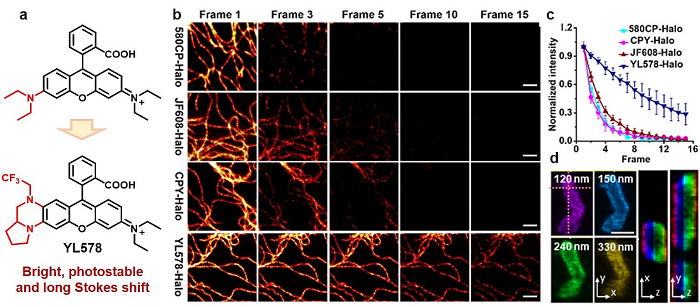
Lu Wang’s group in the School of Pharmacy, Fudan University, and Lin Yuan’s Group in Hunan University have developed a synergistic strategy to develop photostable and bright dyes with long Stokes shift for super-resolution microscopy. The study was published in the Nature Communications (https://www.nature.com/articles/s41467-022-29547-3).
Stimulated Emission Depletion (STED) microscopy, as a super-resolution nanoscopy that breaks the diffraction limit of light, offers a powerful tool to investigate cellular biology on a molecular scale. However, the high-powered depletion laser beam in STED imaging causes severe photobleaching, resulting in more stringent requirements for fluorescent probes. The ideal fluorescent probe for super-resolution imaging should require several key properties, such as brightness, photostability, Stokes shift, excitation/emission wavelengths. However, the development of such probes with multiple properties at once is particularly challenging and thus the ideal probe has not yet been reported. Thus, it would be very valuable to provide a strategy to improve fluorophores multiplexing performance for super-resolution microscopy.
Rhodamine and its derivatives are the popular fluorophores applied in imaging studies due to their exceptional properties, including high brightness, good photostability, and various excitation/emission wavelength. Recently, some strategies have been reported to further improve their properties to further enhance their application in super-resolution microscopy. Suppressing the formation of TICT states can improve the brightness and photostability, while could produce a small Stokes shift (20-30 nm), which often causes self-quenching and low signal-to-noise ratio in fluorescence imaging. Asymmetric fluorophores via introducing alternating vibronic structures can significantly increase the Stokes shift but decrease the brightness of these dyes in aqueous solution.

Figure 1. The conventional and new strategies to improve the brightness, photostability, and Stokes shift.
To address the above challenge, the research group tried to combine the TICT inhibition and vibronic structure and developed a new type of asymmetric rhodamines (Yue Lu dyes, abbreviated as YLs). Among these rhodamine derivatives, YL578 with 2-(2,2,2-trifluoroethyl)octahydropyrrolo[1,2-a]pyrazine moiety shows a significantly enhanced brightness, improved photostability, and expanded Stokes shift. YL578-derived probes show excellent performance in wash-free organelles staining and protein labeling in confocal and STED nanoscopy. The success of simultaneously improving several properties of classic fluorophores in this work demonstrated the extraordinary strength of the synergistic strategy, which will boost many new design strategies to create the next generation of fluorophores.

Figure 2. Super-photostable YL578 derivative in 3D and live-cell STED microscopy.
The first authors of the paper are Gangwei Jiang and Tianbing Ren. The corresponding authors are Dr. Lu Wang and Dr. Lin Yuan.
About this article:
Gangwei Jiang, Tian-Bing Ren, Elisa D’Este, Mengyi Xiong, Bin Xiong, Kai Johnsson, Xiao-Bing Zhang, Lu Wang*, Lin Yuan*. A synergistic strategy to develop photostable and bright dyes with long Stokes shift for nanoscopy. Nature Communications volume 13, Article number: 2264 (2022).
Link to original article. https://www.nature.com/articles/s41467-022-29547-3